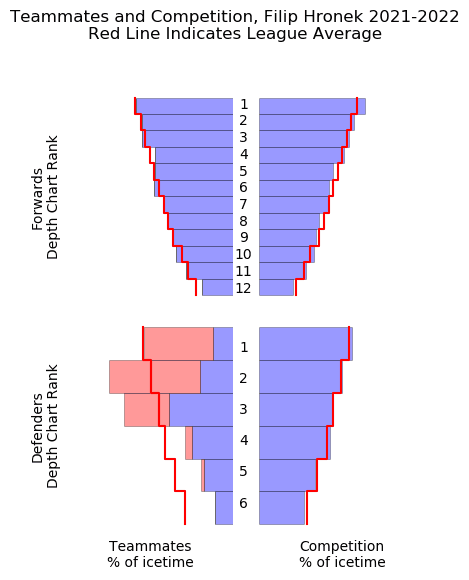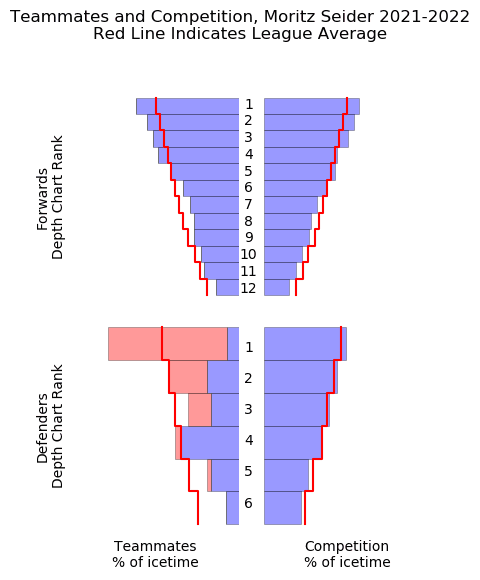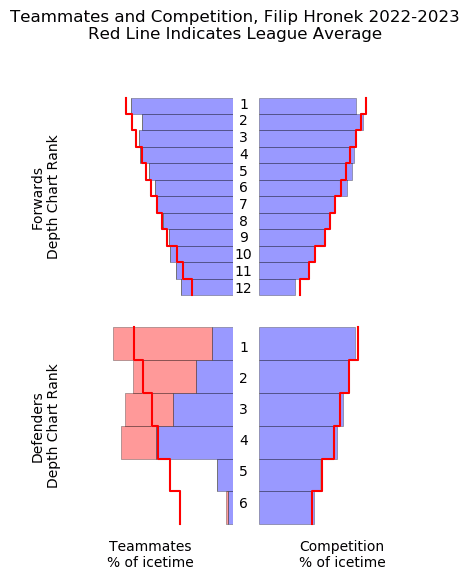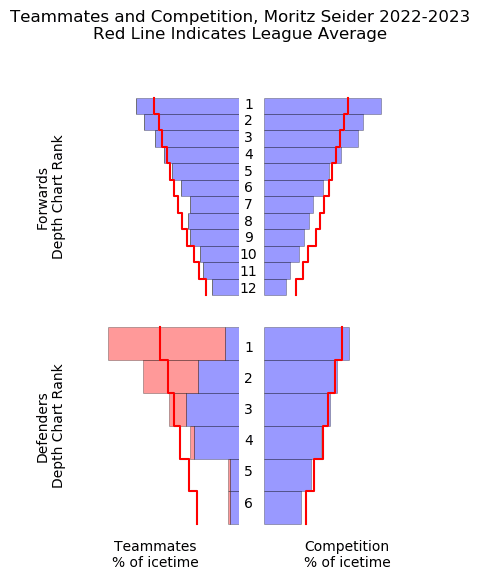Nation Sites
The Nation Network
CanucksArmy has no direct affiliation to the Vancouver Canucks, Canucks Sports & Entertainment, NHL, or NHLPA
Deep Dive II: What kind of defender do the Canucks really have in Filip Hronek?

Photo credit: © Bob Frid-USA TODAY Sports
Aug 13, 2023, 11:29 EDT
Last time, on the Filip Hronek Deep Dive, we took a big, narrative satellite-picture view of the 25-year-old defender’s journey from overtasked rookie to genuine top-pairing-quality player for the Detroit Red Wings.
It was a journey that, as we now know, ended in a March 2023 trade to the Vancouver Canucks.
Flash-forward to the present moment, and those same Canucks aren’t just hoping that Hronek can maintain his 2D level of play in Vancouver, they’ve more or less pinned the future of their blueline on it happening.
With that in mind, we’re taking the Deep Dive even deeper today and getting into the nitty gritty of what makes Hronek so effective, and why those things are transferrable to his new role as the number one RHD on the Vancouver depth chart.
Leaguewide Comparisons
From here on out, we’re going to focus almost entirely on Hronek as he is now; meaning primarily Hronek’s performances from the 2021/22 and 2022/23 seasons, with a hefty focus on 2022/23. As we tracked in our last article, Hronek has shown clear linear progression in each year of his career thus far, and appears to be far more of a developed product than someone experiencing a couple of anomalous and temporary breakout.
With that in mind, let’s place current Hronek in the context of other 2022/23 defenders around the league.
We’ll start close to home with Moritz Seider. It’s important to, because before we can paint Hronek as the Canucks’ 1RHD, we have to acknowledge that he did not hold that position with the Red Wings last year.
When Seider was a rookie in 2021/22, Hronek took on an even greater defensive load to create some breathing space, and his stats reflected that.
By Seider’s sophomore season, however, he was more than ready for prime-time. Seider played 23:09 per night in 2022/23, compared to Hronek’s 21:42.
Now, this is clearly a situation where Hronek was the 2RHD, and yet played a lot more than the average second-pairing defender does. Really, the split of duties was fairly even, with some key differences in special teams and matchups that we will get to in subsequent sections.
Outside of the context of his own team, Hronek starts to stand out as a top-pairing-quality D.
That average ice-time had him in a tie for 54th place among NHL defenders with Morgan Rielly.
His 39 points sit 37th overall, and perhaps most impressively, his nine goals were tied for 34th.
But that’s just offence.
Hronek played 64 games last season with an average even-strength ice-time of 17:38 a night. He allowed just 47 goals against during that time.
If we filter by just those defenders who played as many or more EV minutes, we find that Hronek’s 47 GA ranks in a tie for the fifth-lowest in the league with Jared Spurgeon. The top-six goes Charlie McAvoy, John Marino, Hampus Lindholm, Dmitry Orlov, Spurgeon, and Hronek.
Again, it’s a stat that requires the context of deployment, which we’re about to get to.
But it’s impressive company all the same.
Near the top-30 in putting goals in the opposing net and in the top-ten at keeping them out of his own, a brief tour of leaguewide rankings certainly paints Hronek as a top-pairing-quality defender.
But the Canucks are, believe it or not, going to need more than that from him. They’ve already got Quinn Hughes in the fold, and unless the two of them are going to pair together, the general idea seems to be that Hronek is going to take on a heavier defensive load — perhaps in the form of a shutdown pairing with either Carson Soucy or Ian Cole — so as to allow Hughes more offensive opportunities.
In order to see if he’s up to that task, we have to take a look at Hronek’s history of matchups.
Deployment
The story of how Hronek is deployed and who he matches up against has shifted a little between the 2021/22 and 2022/23 seasons, and we’re again going to tell that story through the lens of Mo Seider.
Since Seider’s rookie season, both he and Hronek have tended to split their starts fairly evenly between the offensive and defensive zones, with each taking a slight lean toward the d-zone.
Hronek had been taking on about league-average matchups in each of his seasons thus far, and that deployment would see a slight uptick in 2021/22.


From HockeyViz.com
We should be clear here, however, that when we say that Hronek was taking on tougher matchups to create breathing room for rookie Seider, we don’t necessarily mean that he was taking on tougher matchups than Seider.
Seider’s capacity for matchups increased gradually throughout his freshman season, and by the end his qualcomp chart was already a fair bit more top-heavy than Hronek’s.
That gap only widened in 2022/23. By this point, Seider was ready to take on some of the hardest minutes in the league, and that left fewer opportunities for Hronek to play shifts against opposing top lines.


From HockeyViz.com
Let’s also be clear in saying that, while this new ratio of competition may be a little less top-heavy than what Hronek had faced earlier in his career, these are still anything but sheltered minutes. Hronek still played a lot in 2022/23, and plenty of those minutes came against top-six competition.
It’s just that, when the very best the opposing team had to offer was on the ice, Detroit tended to throw out Seider before they threw out Hronek. And, really, can you blame them?
But either way, a truth must be reckoned with: Hronek’s first season with genuinely impressive defensive results, his own-zone breakout campaign of 2022/23, came at the exact same time that his overall responsibilities were lessened.
It is, at the very least, food for thought as the Canucks prepare to jack those expectations right back up in 2023/24.
Before we throw too much cold water on Hronek’s shutdown qualifications, let’s note that just because Seider might be better at matchups doesn’t mean at all that Hronek isn’t of top-pairing quality. After all, Seider, is already approaching the very utmost upper echelons of NHL defenders and is only on his second season. He’s a special one.
As well, try this micro-stat on for size.
Last season, when he was matched up against the Eastern Conference’s top-five scorers — David Pastrnak, Nikita Kucherov, Matthew Tkachuk, Jack Hughes, and Mitch Marner — Hronek’s team outscored their opponents to the tune of 4-3.
That’s not bad for what amounted to a decent sample size of minutes against the beasts of the East.
Teammates
We’re going to start our journey through Hronek’s history of D partners in the 2020/21 season, for the sole purpose of explaining why Hronek’s early-career defensive numbers appear so dreadful.

From Dobber’s Frozen Tools
There was a 23-year-old Hronek, playing 23 minutes a night with partners like Danny Dekeyser, Dennis Cholowski, Jon Merrill, Christian Djoos, and our old friend Alex “The Bulldog” Biega. It’s a who’s who of who’s not in the NHL anymore, and it kind of speaks for itself.
As we move into Hronek’s offensive breakout campaign of 2021/22, we a bit of an uptick in quality of partner, but not by much.

From Dobber’s Frozen Tools
By this point in his career, Nick Leddy was firmly on the decline, and had always been a player with a more offensive bent. Marc Staal is still hanging on there, career-wise, but he’s a neutral factor at the best of times and a burdensome partner at the worst.
Mix heavy defensive minutes with partners like that, and Hronek getting a bit caved in makes sense.
It wasn’t until 2022/23 that Hronek got a quality partner, and the results were immediate and obvious.

From Dobber’s Frozen Tools
Alongside Olli Maatta, Hronek’s porousness evaporated completely, and almost all of his numbers rebounded in a positive direction. Again, take this with a bit of caution, as this season also marked the point at which Hronek’s matchups became slightly easier, but he and Maatta were still given plenty of defensive responsibility and handled it with aplomb.
It’s not even that Maatta is particularly good; he’s not. He’s a fairly average, bottom-end top-four defender, and has been for his entire career. It’s just that he’s the first partner to not actively weigh Hronek down, and thus we can take their numbers together as perhaps the best indication of the “true” Hronek.
We’ll let you in on a little secret here…Ben Chiarot sucks. Everyone knows it, except, apparently, the GMs who keep trading for and signing him. Just look at the demonstrable impact that pairing with Chiarot had on Hronek’s numbers.
So, is Hronek the kind of defender who can prop up a bad partner? Yes, but it’s not the best use of his talents and the results may not be pretty.
Is he the kind of defender who can thrive in the top-four with any sort of competent partner? Yes, that appears to be the case.
Is he the kind of defender that can form a reliable shutdown pairing if partnered with a genuinely defensively-talented defender? That remains untested, but there are at least some indications on Hronek’s end that it could be true.
By that we mean, if Hronek can handle tough minutes next to the likes of Marc Staal and Dennis Cholowski and not totally collapse, and if he can handle medium-difficulty minutes with Olli Maatta and put up league-best defensive results, surely there’s room for him to meet with a strongly defensively-oriented partner — say a Soucy or a Cole — and excel under shutdown deployment.
Yes, Hronek’s best defensive results ever came at the exact same time that his teammate Seider started taking on some of the toughest matchups in the league. But it also came at the exact same time that Hronek received his first quality D-partner. Draw your own conclusions on the balance of d-zone factors there.
On the other end of the ice, there’s also more than enough evidence to suggest that, if they ever tried it, the Canucks would have one of the most offensively-potent pairings in the league in Hughes and Hronek together.
We’d argue that the results of this examination are not concrete, but they are encouraging. And we’re not even done yet. We’ve still got the special teams angle to look at, as well as a bevy of advanced and underlying measures.
Tune in for Part III in the days to come
Breaking News
- When Brian Burke offered his thoughts on Elias Pettersson and JT Miller: Top 10 Canucks stories of 2025 – #5
- World Juniors: Canucks’ Cootes and Team Canada beat Czechia 7-5
- When Rick Tocchet was brutally honest about JT Miller’s poor play: Top 10 Canucks stories of 2025 – #6
- Canucks: Why Evander Kane’s trade value might be higher than you think
- Brock Boeser details Allvin’s last-minute phone call that kept him in Vancouver: Top 10 Canucks stories of 2025 – #7
